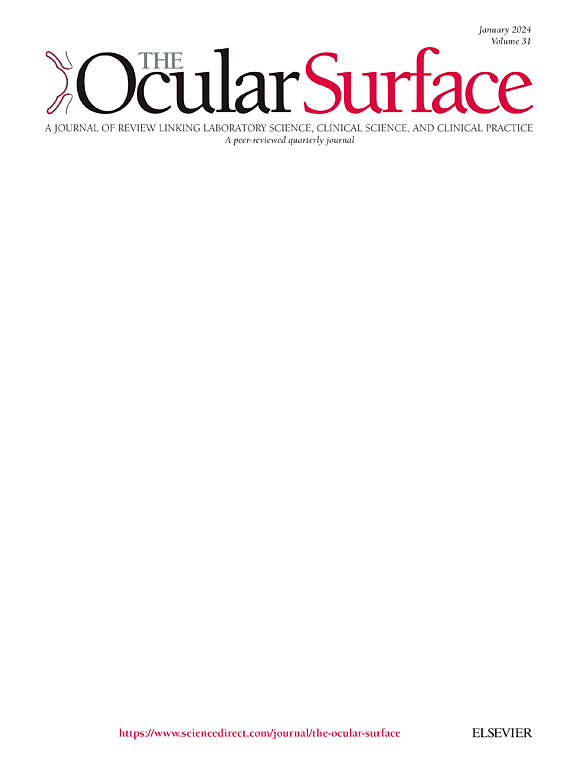细胞外囊泡在调节角膜血管生成、淋巴管生成和神经修复方面的靶标定位和治疗潜力。
IF 5.9
1区 医学
Q1 OPHTHALMOLOGY
引用次数: 0
摘要
细胞外囊泡,包括外泌体,是一种小的细胞外囊泡,直径从 30 纳米到 10 微米不等,具有特定的膜标记。它们是自然分泌的,存在于血液、尿液和唾液等各种体液中,通过其内部货物的多样性,它们对正常的生理和病理过程都有贡献。这些过程包括免疫调节、神经元突触形成、细胞分化、癌症转移、血管生成、淋巴管生成、传染病进展以及阿尔茨海默氏症和帕金森氏症等神经退行性疾病。近年来,人们对外泌体作为一种潜在的药物输送系统用于治疗各种疾病和损伤的兴趣与日俱增。重要的是,源于患者自身细胞的外泌体具有极低的免疫原性、出色的稳定性以及固有的可调节靶向能力。本综述探讨了外泌体在血管生成、淋巴管生成和神经修复中的作用,并特别强调了角膜中的这些过程。此外,它还研究了从特定细胞类型中提取的外泌体,讨论了基于外泌体的疗法在调节这些过程中的优势,并介绍了一些最成熟的外泌体分离方法。基于外泌体的疗法正在成为潜在的微创、非免疫原性疗法,可调节角膜血管生成和淋巴管生成,并增强和加速内源性角膜神经修复。本文章由计算机程序翻译,如有差异,请以英文原文为准。
Target specification and therapeutic potential of extracellular vesicles for regulating corneal angiogenesis, lymphangiogenesis, and nerve repair
Extracellular vesicles, including exosomes, are small extracellular vesicles that range in size from 30 nm to 10 μm in diameter and have specific membrane markers. They are naturally secreted and are present in various bodily fluids, including blood, urine, and saliva, and through the variety of their internal cargo, they contribute to both normal physiological and pathological processes. These processes include immune modulation, neuronal synapse formation, cell differentiation, cancer metastasis, angiogenesis, lymphangiogenesis, progression of infectious disease, and neurodegenerative disorders like Alzheimer's and Parkinson's disease. In recent years, interest has grown in the use of exosomes as a potential drug delivery system for various diseases and injuries. Importantly, exosomes originating from a patient's own cells exhibit minimal immunogenicity and possess remarkable stability along with inherent and adjustable targeting capabilities. This review explores the roles of exosomes in angiogenesis, lymphangiogenesis, and nerve repair with a specific emphasis on these processes within the cornea. Furthermore, it examines exosomes derived from specific cell types, discusses the advantages of exosome-based therapies in modulating these processes, and presents some of the most established methods for exosome isolation. Exosome-based treatments are emerging as potential minimally invasive and non-immunogenic therapies that modulate corneal angiogenesis and lymphangiogenesis, as well as enhance and accelerate endogenous corneal nerve repair.
求助全文
通过发布文献求助,成功后即可免费获取论文全文。
去求助
来源期刊

Ocular Surface
医学-眼科学
CiteScore
11.60
自引率
14.10%
发文量
97
审稿时长
39 days
期刊介绍:
The Ocular Surface, a quarterly, a peer-reviewed journal, is an authoritative resource that integrates and interprets major findings in diverse fields related to the ocular surface, including ophthalmology, optometry, genetics, molecular biology, pharmacology, immunology, infectious disease, and epidemiology. Its critical review articles cover the most current knowledge on medical and surgical management of ocular surface pathology, new understandings of ocular surface physiology, the meaning of recent discoveries on how the ocular surface responds to injury and disease, and updates on drug and device development. The journal also publishes select original research reports and articles describing cutting-edge techniques and technology in the field.
Benefits to authors
We also provide many author benefits, such as free PDFs, a liberal copyright policy, special discounts on Elsevier publications and much more. Please click here for more information on our author services.
Please see our Guide for Authors for information on article submission. If you require any further information or help, please visit our Support Center
 求助内容:
求助内容: 应助结果提醒方式:
应助结果提醒方式:


